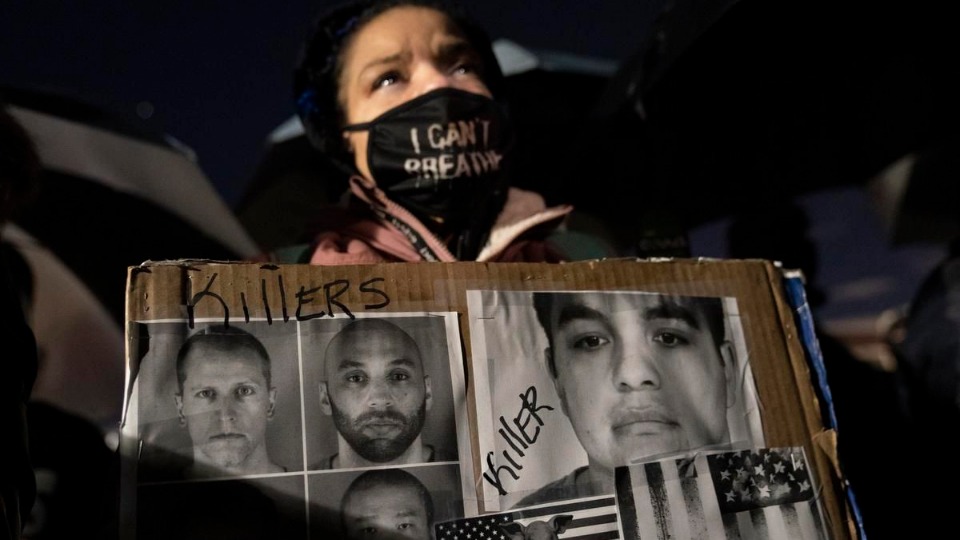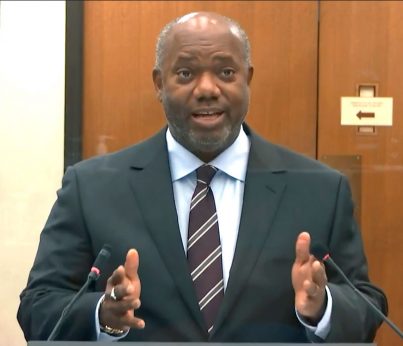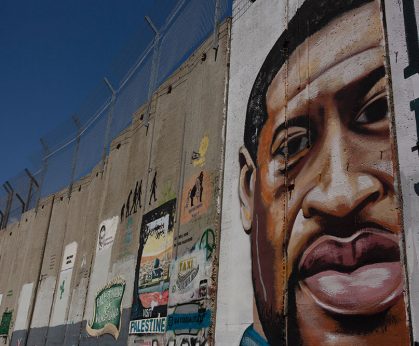
MINNEAPOLIS—On Monday evening, a jury of 12 Hennepin County residents began their deliberations as to Derek Chauvin’s future. Will it be years in prison, or will he leave the courtroom a free person acquitted of the charges? It is nearly incomprehensible to think any jury would not find Chauvin guilty for the murder of George Floyd.
The jurors’ deliberations fall just eight days after Daunte Wright, a young unarmed Black man, was killed by a white police officer in suburban Brooklyn Center just 12 miles from the courtroom in Minneapolis. Wright’s killing has sparked daily protests and escalated tensions and anger.

Monday’s closing prosecution arguments actually began on March 29, when prosecuting attorney Jerry Blackwell told jurors during opening arguments that the most important number they will hear during the trial was 9-2-9. The nine minutes and 29 seconds that Chauvin pressed his knee into Floyd’s neck as Floyd begged to be allowed to breathe.
In delivering closing arguments Monday, prosecutor Steve Schleicher referred to that time period 20 times in his nearly two-hour statement to the jury telling them they should find Chauvin guilty on all three charges. During three weeks of testimony, the jury witnessed Floyd’s death over and over in video taken by bystanders and the body cameras of the four officers involved.
Time and again, Schleicher focused jurors’ attention on those minutes in which they witnessed the life of a human being ended by asphyxiation caused by the unauthorized and excessive force Chauvin and two other Minneapolis police officers used to restrain Floyd.
Can there be a shadow of a doubt that Floyd died of asphyxiation as the prosecution contends? That is the first of two questions the jury must decide. The other is the manner of death. If they reach a guilty verdict, it is because they were convinced by prosecutors that the manner of death was Chauvin’s knee on Floyd’s neck and Chauvin’s callous disregard for Floyd’s deteriorating condition.
Callousness so monstrous that even after Chauvin was told by the other two officers pressing Floyd to the pavement that they could not find a pulse and that Floyd had stopped breathing, Chauvin persisted. For another three minutes, he pressed his knee into Floyd, relenting only after paramedics arrived and asked him to move.
“Use your common sense, believe your eyes, what you saw, you saw,” Schleicher implored the jurors using different words and phrases throughout his remarks. Referring back to Judge Peter Cahill’s instructions to the jury earlier, Schleicher reminded them that “you should not leave your common sense at the courthouse steps.” While the jury must take the evidence and the judge’s instructions into account, Schleicher noted, “a reasonable doubt, is a doubt based upon reason and common sense.”
In rebuttal, Blackwell told jurors, “I am going to talk to you about what I call the 46th witness. You actually have heard from 45 witnesses…but there’s a 46th witness…and that ladies and gentlemen is common sense.” The cause of Floyd’s death is “so simple that a child could understand it. In fact, a child of nine, one of the bystanders, understood it when she said, “Get off of him.” Blackwell added, “That’s how simple it was. Get off of him, common sense.”
Schleicher reminded jurors that in the first place the officers overreacted to the complaint that Floyd allegedly passed a counterfeit $20 bill—an infraction that the MPD’s chief of police testified does not generally warrant taking a suspect into custody. In Blackwell’s opening argument, he told jurors that issuing a simple citation is the norm. Yet, in a video Schleicher showed, officer Thomas Lane is seen saying to another officer that Floyd was being arrested for forgery.
In another video, Schleicher showed Lane’s initial contact with Floyd, when he was sitting in his vehicle across from Cup Foods. It shows Lane yelling expletives at Floyd with his gun pointing directly at Floyd’s head. This initial behavior of the officers is often lost in focusing on the nine minutes and 29 seconds. The fact is the brutal treatment of Floyd and the officers’ excessive use of force begins from the moment they arrive.
Chauvin’s attorney, Eric Nelson, told the jurors the defense case rests on two questions. Was the force used by Chauvin an “authorized use of force”? Although senior MPD officers testified it was not reasonable, Nelson sought to cast doubt by showing video of Floyd begging to be given time to get in the squad car as he is claustrophobic. Nelson alleged this and other actions of Floyd amounted to resisting officers’ directives.
From the start of the trial, the defense’s strategy has been to cast doubt on the cause of death. That it was not Chauvin’s knee, but the result of Floyd’s drug use and the condition of his heart and arteries.
Nelson and Chauvin are hoping that at least one juror leans in favor of the defense’s argument. A holdout by one or more jurors could result in a hung jury. Under the U.S. system of justice, a unanimous verdict is required in a criminal case, whereas unknown to most Americans, in the judicial systems of other nations a majority verdict can prevail.
The most critical moment in this case, Nelson said, is “what is happening at the precise moment that Mr. Floyd takes his last breath.” One of the bystanders steps closer to insist that officers check Floyd’s pulse. She is warned to move away and complies. Nelson claims, as he showed the video of the scene, that it caused Chauvin to become distracted by the crowd. Nelson suggests to the jury “the critical importance of this moment…in this case.” That is what he alleged, but the tactic shows a defense grasping at straws to justify the use of unlawful force.
To refute defense claims about the cause of death, prosecutor Schleicher systemically reviewed the testimony of the state’s world-class medical experts about the cause of death. They testified as to the physiological changes Floyd presented in the videos, along with forensic evidence, and concluded with a high degree of medical certainty that Floyd died from low oxygen—asphyxia. Further, they concluded that the manner of death was Chauvin’s knees on Floyd’s neck and his upper back while Floyd was in the prone position, a position Chauvin would have known from his training endangers someone in custody.
Schleicher ended the state’s closing arguments by returning jurors’ attention to the bystanders who were outside Cup Foods imploring the officers to let Floyd breathe, to get off him, and to check his pulse. These are bystanders “from the community randomly chosen by fate.” They were just going about their daily activities and became “witnesses to nine minutes and 29 seconds of a shocking abuse of authority.”
“You can see their panic,” he said. “They bore witness to this outrageous act. And they told you about it, they gave you what they had: Their thoughts, their impressions, their memories,” as he referred to the dramatic testimony each of them gave in court. “They gave you those precious recordings so you can see this from every single angle.”
“You can believe your eyes. It’s what you know in your heart. This was not policing, it was murder.”
It is doubtful one could find more than a few dozen of the 420,000 residents of Minneapolis who think Chauvin is innocent. The city, along with St. Paul, is virtually under military and police occupation, presumably in the event the jury were to acquit. Chauvin faces charges of second-degree unintentional murder, third-degree murder, and second-degree manslaughter. The state asked the jury for a guilty verdict on all charges.
A guilty verdict for murder would send the first white officer in Minnesota to prison for killing a Black man. The only officer previously convicted is former MPD officer Mohamed Noor, a Black man, for killing a white woman. Sending Chauvin to prison would be a blow to the blue code of silence that prevails in police departments across the nation. Until a white officer is sitting in prison, no amount of police reform will change police behavior toward people of color. As such, this case has significance far beyond this trial.

The entire trial has been streamed live around the world; anyone with access to the internet could watch. Floyd’s murder and the subsequent uprising in Minneapolis against this heinous example of police violence spread across the nation and then across the globe. The sheer number of demonstrators compares to the outpouring of protest in the U.S. and globally to stop the U.S. invasion of Iraq in 2003.
It’s estimated that in the month-long rebellion following Floyd’s murder, 20 to 25 million people participated in marches, vigils, and protests across the U.S., in thousands of cities large and small. The day after Floyd’s death, at least 25,000 people from Minneapolis and surrounding communities converged on the neighborhood where Floyd was murdered.
The world is watching and waiting for justice for George Floyd.









